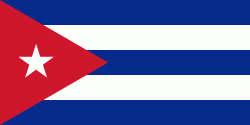Gibara (Municipio de Gibara)
 |
The main town was founded on January 16, 1817. It is also known as "The White Town", La Villa Blanca. Gibara has a beautiful and breezy landscape, and also possesses excellent architectural designs and a well-planned layout of its streets, houses and parks. Even so, Gibara's biggest asset, according to visitors, are its people, which are described as cooperative, friendly, affectionate, and proud of their village and of its history. It is said Admiral Christopher Columbus had remarked of Gibara's environs that "it is the most beautiful land that human eyes saw."
"The White Villa" in Gibara, although small, is said to possess a peculiar charm, exhibiting an architectural patrimony reflecting almost two centuries of history, as well as its people's cultural roots. Currently, some controversy exists about whether it was the Bay of Gibara or the Bay of Bariay that Columbus' ships reached during his first voyage to Cuba. The island of Cuba was discovered on October 28, 1492, after the disembarkation of La Pinta, La Niña and La Santa María, the first three European ships under the command of Columbus during his first trip toward the New World.
Gibara was declared a National Monument in 2002; additionally, since 2003, the International Festival of Cinema, where films are presented in a number of different categories, has been held in this small coastal town.
Map - Gibara (Municipio de Gibara)
Map
Country - Cuba
 |
 |
| Flag of Cuba | |
The territory that is now Cuba was inhabited by the Ciboney people from the 4th millennium BC with the Guanahatabey and Taíno peoples until Spanish colonization in the 15th century. From the 15th century, it was a colony of Spain, and slavery was abolished in 1886, remaining a Spanish colony until the Spanish–American War of 1898, when Cuba was occupied by the United States and gained independence in 1902. In 1940, Cuba implemented a new constitution, but mounting political unrest culminated in a coup in 1952 and the subsequent dictatorship of Fulgencio Batista, which was later overthrown in January 1959 by the 26th of July Movement during the Cuban Revolution, which afterwards established communist rule under the leadership of Fidel Castro. The country was a point of contention during the Cold War between the Soviet Union and the United States, and a nuclear war nearly broke out during the Cuban Missile Crisis of 1962. Following the collapse of the Soviet Union, Cuba faced a severe economic downturn in the 1990s, known as the Special Period. In 2008, Fidel Castro resigned after 49 years of leadership of Cuba and was replaced by his brother Raúl Castro.
Currency / Language
| ISO | Currency | Symbol | Significant figures |
|---|---|---|---|
| CUC | Cuban convertible peso | $ | 2 |
| CUP | Cuban peso | $ | 2 |
| ISO | Language |
|---|---|
| ES | Spanish language |















